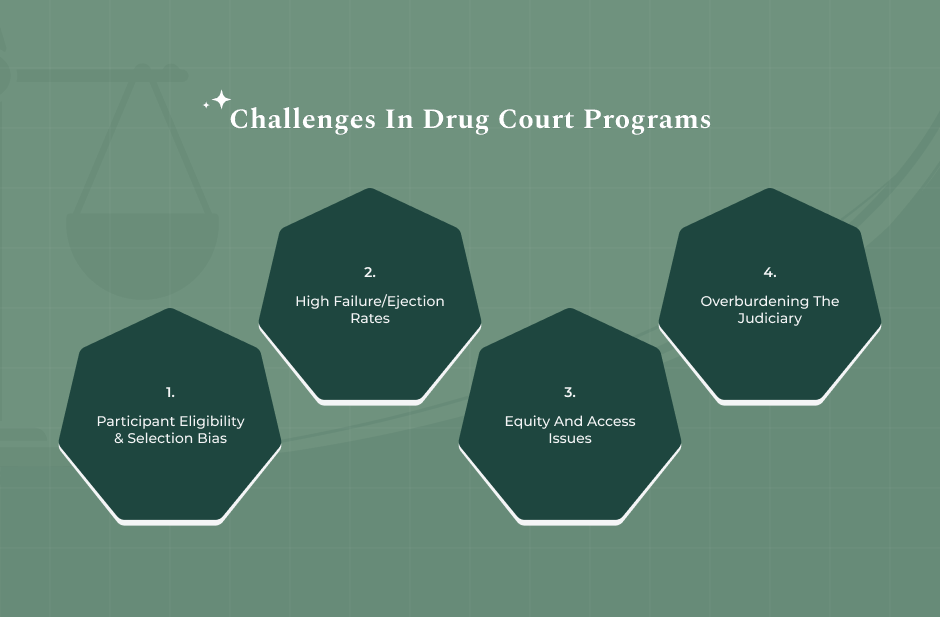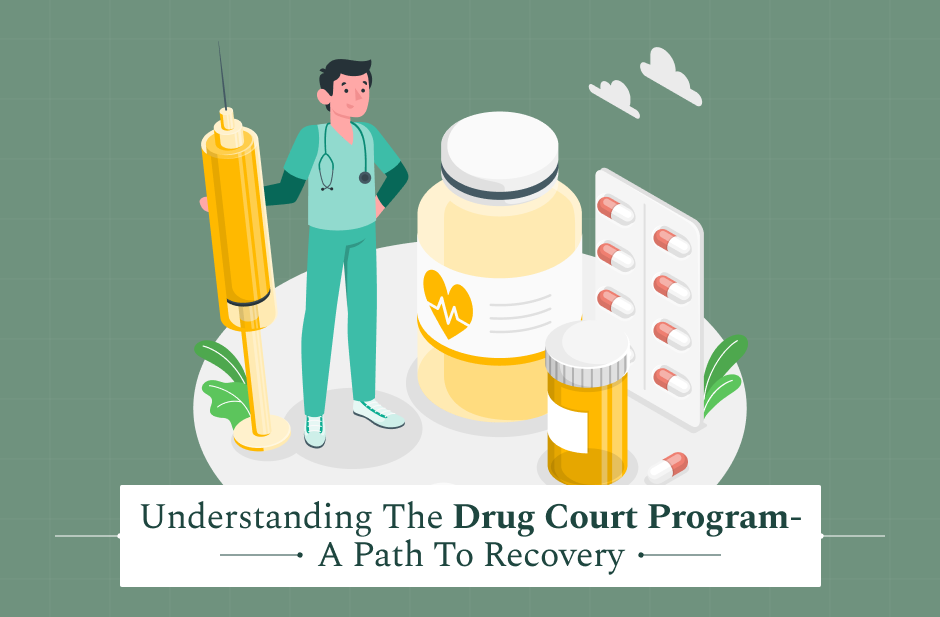Substance use disorder affects millions of Americans, and many have active criminal charges stemming from their addiction. Traditionally, the justice system treated these cases punitively; high rates of re-arrest followed suit. A specialty system does exist for such cases, though. The drug court program brings a sense of promise with regard to how individuals may be treated differently.
“In 2011, there were an estimated 12.4 million arrests, including 1.5 million for drug offenses (possession or sale),” according to PMC’s Treating Substance Use Disorders in the Criminal Justice System.
The Drug Court program is known for its therapeutic approach. It is based on justice through judicial authority helping offenders get long-term treatment and recovery.
Most importantly, the program targets the cycle of addiction and crime. It helps the victim get back to their family and community.
Data from the U.S. Department of Health and Human Services talk about judicial dockets like the drug court. It shows that the program focuses on treatment instead of incarceration for individuals suffering from substance use disorder (HHS.gov).
This article will explain exactly how the drug court program works.
What Is A Drug Court Program?

A Drug Court program refers to a special court system that uses treatment, not punishment, for criminal defendants with addictions. It operates on a different philosophy called “therapeutic justice.” It recognizes that many crimes stem directly from substance use disorder.
Core Features And Team Model
The drug court program applies the team-based model. The model encompasses an intense manner of collaboration between different professionals.
Key members of the drug court team include:
The judge monitors the participant’s rehabilitation and provides regular, personal contact.
- Next, Prosecutor and Defense Counsel
The parties agree that treatment is the paramount objective.
- Treatment provider
These are the people providing patient’s clinical care.
- Probation/Supervision Officer
These people look into compliance and also monitors behavior of the individuals.
The National Association of Drug Court Professionals developed Ten Key Components for the guiding philosophy of such courts. Most notably, these components call for multidisciplinary collaboration, and ongoing judicial monitoring. Through all, the drug court program seeks accountability in a nurturing framework.
Purpose And Rationale
Drug court program models arose in the late 1980s as an explicit response to the futility of merely incarcerating drug-addicted persons. Studies continually indicated that incarceration alone did little to deter drug use or cut crime after release. The drug court program recognizes addiction as a public health issue. The focus really stays on saving lives and managing crime.
Who Is Eligible For The Drug Court Program?
Not everyone qualifies for a drug court program. Specific eligibility requirements greatly vary from state to state and even from jurisdiction to jurisdiction. However, some common criteria are applied across the board nationwide.
First, the offense must be connected with the defendant’s substance use disorder. Generally speaking, only defendants charged with non-violent offenses can be eligible. Defendants who have previously suffered severe violent felony convictions generally will not qualify.
The screening process consists of several steps:
1. Legal Review
The prosecutor and defence attorney start by going through the list of charges. They check if the offence is non-violent.
2. Clinical Assessment
Here, as a part of the treatment, the professionals start with an assessment. Here, they test the severity of the substance use disorder. Additionally, they also check if the person has chances of re-offending. Ultimately, it also depends on how responsive the individuals are to treatment (Office of Justice Programs).
3. Judicial Consent
The judge has to approve the applicant. Also, the defendant has to accept the participation in the whole process willingly.
Drug Court Requirements
Participation in a drug court program requires a full commitment. The eligibility criteria are strict and highly structured. Typical drug court requirements include:
- Attending frequent status hearings before the drug court judge.
- Participating in required, evidence-based substance abuse treatment.
- Meeting with a probation officer or court representative frequently.
- Employment and job security, furthering one’s education.
- Undergoing random drug testing.
How The Drug Court Program Works
The drug court program is intensive and highly supervised. It generally lasts from 12 to 18 months, divided into several progressive phases.
Phase Flow and Structure
Participants go through three or four distinct phases:
Phase 1- Intensive Supervision
This is the stabilization phase. Participants are in court, treatment, and self-help meetings several times a week. Drug testing is most frequent during this phase.
Middle Phases
Supervision will gradually be reduced during these phases. The focus of the middle phase will be finding employment, improving life skills and enhancing recovery support networks.
Graduation Phase
This is the final phase. They see to it that the individual shows long-term sobriety. So, as a part, the individual has to show that they can lead a proper life when outside strict programming.
Treatment and Support Services
Recovery necessitates integrated care. The drug court program requires more than just counseling. Treatment services include:
Outpatient or residential treatment.
- Medication-Assisted Treatment
This actually involves use of FDA-approved medicines. For example, buprenorphine.
- Mental health counseling and other simultaneously occurring disorders.
Additionally, there is also housing-related assistance, job training, and educational support.
Monitoring And Accountability
Accountability is central to the effectiveness of the drug court model. The court applies immediate incentives and sanctions as the basis for its behavioral modification approach.
Incentives
For positive actions, for example, a clean drug test or finding a job, there are rewards. Examples include verbal praise from the judge, reduction in supervision, or gift cards.
Sanctions
Infringement leads to immediate, certain sanctions. Sanctions include increased court appearances, community service, or a short stay in jail.
Also, respondents agree to random and frequent tests for drugs. Does the court have the right to drug test you without warning? Yes, the court does have the right to drug test you without any warning to assure integrity and continuous sobriety.
Evidence And Outcomes: Does The Drug Court Program Work?
The key question for policy officials and the public at large is whether the drug court program reduces crime. The answer is unequivocal.
Recidivism Reduction
Studies consistently support the fact that the drug court program does indeed reduce future crime. For example, meta-analysis research of the adult drug courts demonstrates a reduced recidivism rate compared to traditional sentencing.
One broad review found that the adult drug courts reduce recidivism among participants. Here, the rate often drops from a national average of roughly 50% down to about 38% (ScienceDirect). The program provides a net benefit to public safety.
Cost-Benefit And Limits
The drug court program also shows great financial benefits. Though the initial treatment cost is very high, the costs for imprisonment and reduced crimes offset it well. For every dollar spent, for instance, studies calculate that the savings generated by drug courts range between $2 and $3.
The National Institute of Justice corroborates this very positive net benefit. However, there are variations in program effects. Thus, fidelity to the core model must be maintained by the courts to achieve the optimum results.
Variations On The Drug Court Program Model
This original adult drug court program gave rise to a number of specific model variations that adapt the principle to targeted populations.
Adult vs. Juvenile Drug Courts
The adult model targets justice-involved individuals 18 and older. Juvenile Drug Courts target young people. Research indicates that JDCs confront especially singular challenges. Some research has warned that certain juvenile courts underperform relative to traditional probation (Office of Justice Programs).
Because of this, JDCs require highly specialized treatment and focus on family engagement.
Specialty Drug Courts
First, we talk about the Family Drug Courts.
These courts work with parents who have cases of abuse or neglect within the child welfare system. The focus is still on reunification and sobriety for the parents.
Next, come the Veterans Treatment Courts.
These provide services to veterans with substance use disorders and often help connect participants with specialized VA benefits and other resources.
Tribal Healing to Wellness Courts, third.
The model is adapted in tribal courts to include indigenous healing practices and traditions.
Challenges And Ethical Considerations

Despite the success that has been recorded through the drug court program, there is still criticism. The challenges are continuously tackled through practice and research.
Equity And Access Issues
Racial and ethnic disparities persist. Various studies reflect that selection bias, at times, exists in who gains entry into the drug court program. Advocates work to ensure that eligibility criteria and the screening processes are applied equitably so all may have equal access to this life-changing opportunity.
Due Process Tension
Critics view that the dual role of the judge creates a tension with due process since he serves as both the source of support and a sanctioning authority. The system requires participants to waive certain rights in exchange for treatment. Courts must implement clear rules and judicial fairness as a means to avoid such legal and ethical risks.
Read Also: Detention Hearing Explained – Purpose, Procedure & What To Expect
Best Practices For The Success Of The Drug Court Programs

Success is achieved with implementation fidelity. The drug court program must be implemented as specified by the defined components.
Fidelity And Enhancement
The courts should focus on continuous quality improvement by implementing regular audits to assure the program adheres to best practices. Rigorous adherence to the model ensures maximum recidivism reduction.
Trauma-Informed Care
The treatment must be trauma-informed and client-centered. Participants have generally experienced substantial traumatic events, so drug court and its contracted treatment agencies need to address the core underlying issues if true healing is to occur.
The center of focus is always long-term wellness.
The Drug Court Programme changes lives. It gives a fine example of the influence of embedding public health principles into the criminal justice system. We covered what exactly is drug court and how it functions.
Understanding the drug court requirements shows the level of commitment needed. The success of the drug court program gives a clear roadmap for future reform in criminal justice.
Read Also: What Is Condemnation? Understanding The Legal Process Of Property Seizure
Frequently Asked Questions (FAQs):
It is common to have questions regarding the logistics and access to the drug court program. Always consult with a local defense attorney or the court clerk’s office for the most specific information.
Following are the answers to three common questions about the Drug Court program:
Implementation in low-resource settings is possible, but it takes some creative collaboration. The courts often use telehealth and strong community partnerships with local non-profits to provide the needed treatment and supervisory services where specialized infrastructure does not exist.
The immediate, graduated sanctions due to the Drug Court program mean that a missed date or a positive drug test is met with a swift but proportionate response, such as increased drug testing, an essay assignment, or a short jail stay. Termination of the program is generally a last resort, reserved for repeated, egregious non-compliance.
The central question of what a drug court is answered in its mission: treatment instead of jail. Although most of the participants have felony charges, drug courts also take in those with misdemeanor charges.
The main determining factors are the presence of an underlying substance use disorder and that the offense be non-violent.

















